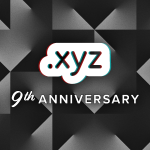Breaking the Mold
Posted by Daniel Negari in Featured, gTLDs
Three years ago, my team and I launched .xyz with the mission of bringing competition, choice, and innovation on the internet. .xyz was probably the only domain extension that had no built-in meaning, included very few domains priced at a premium, and relied on low margins and high volume. We brought with it the message that .xyz was for every website, everywhere. And instead of targeting one vertical, we connected with the next generation of internet users, such as young adults, new businesses and startups, and people in emerging internet markets. Even before launch, we had introduced the concept of Generation XYZ, the online community we have now been fostering for years to connect people all over the world, regardless of their age, location, or interests.
Today, the #GenXYZ community is made up of millions of business and individuals from over 230 countries, and .xyz is the most popular new domain in over 80 of them, according to nTLDstats. All in all, .xyz has been registered at over 180 registrars – more than any other gTLD. Adoption ranges from creative users, like Point in Passing’s VJ tool, WWWWWWWWWWWWW.xyz, and Dr. Adam’s StreetMedicine.xyz series; to industry leaders including MIT’s startup accelerator, Engine.xyz, and Deloitte’s leadership communities, such as Exponentials.xyz and GoInnovate.xyz. Then there are the truly innovative registrants, like Driver.xyz, who is launching their cancer treatment platform later this year, and Google’s parent company, Alphabet, with one of the best domains on the internet: ABC.xyz.
Thanks to our creative global marketing efforts and passionate customers, .xyz has received extensive media coverage from many of the most respected media outlets in the world. Whether it’s the #XYZsquad getting on TV or Starship.xyz receiving $17 million in funding, more and more people are learning that .xyz is the new go-to domain ending for their next project or venture. I have also had the pleasure of speaking on air with Maria Bartiromo on Fox Business News, Emily Chang on Bloomberg, and David Kestenbaum on NPR, among other stations, as well as with major publications like Wired and Reuters. The result of our relentless coverage led to XYZ’s first ever award as a Techweek 100 Innovator, and my recognition as a Techweek 100 Ambassador in 2016.
Rather than resting on our laurels, my team and I set out to come up with a new concept that would appeal to the audiences that have helped make .xyz what it is today. We wanted to continue to foster innovation and creativity, and I really worked hard to think of a way of utilizing the domain naming system (DNS) in a manner that had not yet been exploited. That’s when I learned of a bulk registrant in China who had created a currency using thousands of 6-digit numeric .xyz domains that started or ended with “88.” The registrant had requested a price reduction on an ongoing basis to support the development and tradability of these domains, since $10 renewal and transfer fees were cost prohibitive for this alternative domain usage.
As a dreamer, I started to wonder how many other registrants out there with equally interesting ideas could utilize hundreds, thousands, or even millions of .xyz domain names, whether it be a digital currency, for the Internet of Things (IoT), or any other yet-to-be discovered purpose.
This brought the opportunity for .xyz to create a solution for innovators and entrepreneurs by reclassifying 1.111 billion domains to just $0.65 per year wholesale ($0.99 recommended retail price) to create, renew, and transfer. It then occurred to me that this new concept, called the 1.111B® Class, could be a game changer.
My team and I have worked tirelessly for months to coordinate with registrars all over the world to carry the 1.111B® Class of .xyz domains for $0.99 or less per year, in what we expect to be one of our biggest marketing campaigns to date. And despite restrictions preventing us from formally adjusting the price for these domains to $0.65 until 11/11, the level of support from our partners has been stellar.
One thing that nearly every person we talked to agreed on is that this is an exciting time and incredible opportunity for the DNS. When domains were introduced over 30 years ago, it was with the purpose of adding memorability and utility to IPv4 addresses. Today, all 4.3 billion IPv4 addresses are unavailable. In fact, demand is still so high that 1,024 of these once-free addresses just sold for $13,824 USD in an auction ($13.50 each) last week. That puts the market cap of IPv4 addresses at over $57 billion ($13.50 x 4,294,967,296).
The solution to the exhaustion of IPv4 was IPv6. There are essentially an unlimited number of IPv6 combinations available – approximately 3.4 x 1038 alphanumerics in total. But with the emergence of IoT, it’s now more important than ever for people and devices to seamlessly connect. Because if no one wanted to remember 192.169.0.1, who would want to remember 2a03:2880:f10d:83:face:b00c::25de (one of the better vanity addresses owned by Facebook)? One of the obvious plays here is to apply to ARIN or a local network authority and get IPv6 addresses for free, then route 1.111B domains to them. An affordable automated service like this could easily replace IPv4 addresses in both memorability and utility.
Since 1.111B® Class .xyz domains can be registered as needed for under $1 each, businesses can scale up or down, depending on their needs, with a nominal commitment. For example, Waive.Car, the ad-supported EV car-sharing startup, could register a 1.111B® Class domain to match each license plate in its fleet. And as their 400-car deployment in partnership with Hyundai rolls out in 2017, they could buy more and more matching domains. These domains, paired with each car, could not only be the line of communication between the Waive.Car mothership and its fleet, but also serve as a browser-based tool for drivers to locate their cars, check the battery charge, or report an issue. This same concept can be applied to virtually any piece of hardware or software in the world, since every product has a unique manufacturer’s serial number.
But man-made products aren’t the only things using unique identifiers – people and animals do too. In the workplace, 1.111B® Class domains can be assigned to every employee at a business as a method of handling time clocking, personnel records, or even a company directory. New solutions are already emerging for individuals to register a domain matching their phone number (or a different number for privacy) and easily set up 1-click VoIP calling through a browser-based interface. One of my favorite ideas came from a registrar who suggested pairing 1.111B names with pet microchips, in order for owners to find their pets or simply publish contact information or a message in real-time if someone else finds them. The possibilities really are endless.
In my opinion, the DNS is a superior decentralized platform to cryptocurrency blockchains. Even as a technophile, Bitcoin and Ethereum still feel complicated to me. I actually have a member of my team manage my Bitcoins for me, since it wasn’t intuitive and I was concerned with security. As the backbone of the internet, the DNS is probably the most secure and stable platform in the universe. With .xyz being the root, second level domains (the characters left of the dot) can be securely registered, managed, and traded at thousands of registrars and resellers all over the world with built-in support. WHOIS privacy can be enabled or disabled to show clear title to certain domain names. Locking mechanisms, 2-factor authentication, transfer authorization codes, and other measures are already in place. Carry costs and transaction fees are both under $1. To me, having a class of domains that can transport countries – or planets in the future – that can also be used for routing, email, hosting, and other purposes for less than a dime per month, is more disruptive than AWS introducing on-demand cloud servers to the hosting industry. It is only a matter of time.
In case you’re wondering, Bitcoin has a market cap of over $35 billion ($2,163 x 16,362,462) and the Ethereum market cap is over $20 billion ($225 x 92,078,495). That makes IPv4 addresses worth more than Bitcoin and Ethereum combined!
I’ve been asked on more than one occasion why I chose 6, 7, 8, and 9-digit .xyz domains for this class. The simple answer is people can remember 9-digit phone numbers, and having a limit of 1.111 billion options will create a natural demand for these domains that will increase their value over time based on memorability, DNS queries, sequential block availability, and other factors.
Ultimately, we are serving the 1.111B® Class as a platform to foster innovation and creativity. We are making the domains universally available in the DNS to be registered and managed securely at registrars around the world. As with anything new and disruptive, I predict that it may take several years for the 1.111B® Class concept to fully bake. It’s worth noting though that Bitcoin was worth less than $0.10 for most of 2010, and didn’t cross $1,000 until November 2013, according to CoinDesk. But anyone who invested $100 in Bitcoin 7 years ago could have cashed out over $70 million last week. I expect a future where these inexpensive domains will not only be used for innovative new technologies, but also become scarce and tradable assets once people build exchanges and marketplaces. The future is in your hands.
Innovators like the ones reading about my vision today are in a position to get ahead of the curve, secure blocks of domains, and shape what the future will look like. We have set a global stage that has capacity for true innovation. I am really looking forward to seeing multibillion dollar networks and marketplaces get created using 1.111B® Class .xyz domains.
To learn more about the 1.111B® Class, read the white paper or visit www.gen.xyz/AYDACFU. Download available domains in our new 1.111B<® Class search tool.
Thank you for all your support. Go innovate
#GenXYZ
D






